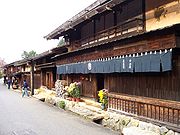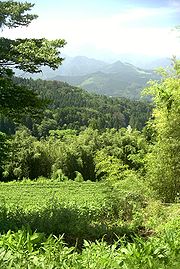
Kisoji
Encyclopedia

Kiso Valley
The is a geographical area that centers on the valley of the upper portions of the Kiso River in the southwestern part of Nagano Prefecture in Japan...
that stretched from Niekawa-juku
Niekawa-juku
was the thirty-third of the sixty-nine stations of the Nakasendō. It is located in the present-day city of Shiojiri, Nagano Prefecture, Japan.-History:...
in Nagano Prefecture
Nagano Prefecture
is a prefecture of Japan located in the Chūbu region of the island of Honshū. The capital is the city of Nagano.- History :Nagano was formerly known as the province of Shinano...
to Magome-juku in Gifu Prefecture
Gifu Prefecture
is a prefecture located in the Chūbu region of central Japan. Its capital is the city of Gifu.Located in the center of Japan, it has long played an important part as the crossroads of Japan, connecting the east to the west through such routes as the Nakasendō...
. There were eleven resting spots along the route, all of which became part of the Nakasendō
Nakasendo
The , also called the , was one of the five routes of the Edo period, and one of the two that connected Edo to Kyoto in Japan. There were 69 stations between Edo and Kyoto, crossing through Musashi, Kōzuke, Shinano, Mino and Ōmi provinces...
when it was established. There is an article dating from 713
713
Year 713 was a common year starting on Sunday of the Julian calendar. The denomination 713 for this year has been used since the early medieval period, when the Anno Domini calendar era became the prevalent method in Europe for naming years.- Byzantine Empire :* Byzantine Emperor Philippicus is...
in the Shoku Nihongi
Shoku Nihongi
The is an imperially commissioned Japanese history text. Completed in 797, it is the second of the Six National Histories, coming directly after the Nihon Shoki and followed by Nihon Kōki. Fujiwara no Tsugutada and Sugano no Mamichi served as the primary editors...
that records the routes characters as 吉蘇路.
There are two stone markers that indicate the end points of the Kisoji. One is located between Motoyama-juku
Motoyama-juku
was the thirty-second of the sixty-nine stations of the Nakasendō. It is located in the central part of the present-day city of Shiojiri, Nagano Prefecture, Japan.-History:...
and Niekawa-juku and states "From here south: Kisoji" (是より南 木曽路 Kore yori minami, Kisoji). The other marker is located between Magome-juku and Ochiai-juku
Ochiai-juku
was the forty-fourth of the sixty-nine stations of the Nakasendō. It is located in the present-day city of Nakatsugawa, Gifu Prefecture, Japan. The honjin and the sub-honjin, as well as some old street lights, remain from the Edo period. The Honjin were the main rest areas in old post towns and...
and states, "From here north: Kisoji" (是より北 木曽路 Kore yori kita, Kisoji).
Additionally, the early 20th-century author, Shimazaki Tōson
Shimazaki Toson
is the pen-name of Shimazaki Haruki, a Japanese author, active in the Meiji, Taishō and early Shōwa periods of Japan. He began his career as a romantic poet, but went on to establish himself as a major proponent of naturalism in Japanese fiction.-Early life:...
, wrote about the effects of the Meiji Restoration
Meiji Restoration
The , also known as the Meiji Ishin, Revolution, Reform or Renewal, was a chain of events that restored imperial rule to Japan in 1868...
on the Kiso Valley in his novel, Before the Dawn. He grew up in Magome-juku, hence his featuring the area in his novels.
After the Meiji period
Meiji period
The , also known as the Meiji era, is a Japanese era which extended from September 1868 through July 1912. This period represents the first half of the Empire of Japan.- Meiji Restoration and the emperor :...
, the Chūō Main Line
Chuo Main Line
The , commonly called the Chūō Line, is one of the major trunk railway lines in Japan. It runs between Tokyo and Nagoya, although it is the slowest direct railway connection between the two cities; the coastal Tōkaidō Main Line is slightly faster, while the Tōkaidō Shinkansen is the fastest rail...
and Route 19
Japan National Route 19
National Route 19 is a national highway connecting Nagoya and Nagano in Japan.-Route Data:*Length: 258.9 km *Origin: Atsuta-ku, Nagoya, Nagoya *Terminus: Nagano City...
were established, which roughly follow the Kisoji's path.
Stations of the Kisoji

Nagano Prefecture
is a prefecture of Japan located in the Chūbu region of the island of Honshū. The capital is the city of Nagano.- History :Nagano was formerly known as the province of Shinano...
- 1. Niekawa-jukuNiekawa-jukuwas the thirty-third of the sixty-nine stations of the Nakasendō. It is located in the present-day city of Shiojiri, Nagano Prefecture, Japan.-History:...
(ShiojiriShiojiri, Naganois a city located in Nagano, Japan. Its name literally means "the end of salt".-History:Municipal Area Changes* April 1, 1927-The village of Shiojiri gained town status....
) - 2. Narai-jukuNarai-jukuwas the thirty-fourth of the sixty-nine stations of the Nakasendō, as well as the second of eleven stations along the Kisoji. It is located in the present-day city of Shiojiri, Nagano Prefecture, Japan.-History:...
(Shiojiri) - 3. Yabuhara-jukuYabuhara-jukuwas the thirty-fifth of the sixty-nine stations of the Nakasendō, as well as the third of eleven stations on the Kisoji. It is located in the present-day village of Kiso, in the Kiso District of Nagano Prefecture, Japan. Yabuhara-juku is located shortly before the Torii Pass, which was the most...
(Kiso (village)Kiso, Nagano (village)is a village located in Kiso District, Nagano, Japan.As of 2003, the village has an estimated population of 3,438 and a density of 24.48 persons per km². The total area is 140.46 km².-External links:*...
, Kiso DistrictKiso District, Naganois a district located in Nagano Prefecture, Japan.As of November 1, 2005, the district has an estimated population of 34,759. The total area is 1,546.26 km².Historically, the district was once known as Nishichikuma District until May 1, 1968....
) - 4. Miyanokoshi-jukuMiyanokoshi-jukuwas the thirty-sixth of the sixty-nine stations of the Nakasendō, as well as the fourth of eleven stations on the Kisoji. It is located in the present-day town of Kiso, in the Kiso District of Nagano Prefecture, Japan.-History:...
(Kiso (town)Kiso, Nagano (town)is a town located in Kiso District, Nagano Prefecture, Japan.The town was founded on November 1, 2005, when the town of Kisofukushima was merged with three villages , all from Kiso District....
, Kiso District) - 5. Fukushima-jukuFukushima-jukuwas the thirty-seventh of the sixty-nine stations of the Nakasendō, as well as the fifth of eleven stations on the Kisoji. It is located in the present-day town of Kiso, in the Kiso District of Nagano Prefecture, Japan.-History:...
(Kiso (town), Kiso District) - 6. Agematsu-jukuAgematsu-jukuwas the thirty-eighth of the sixty-nine stations of the Nakasendō, as well as the sixth of eleven stations on the Kisoji. It is located in the present-day town of Agematsu, in the Kiso District of Nagano Prefecture, Japan. From the present-day Jūō Bridge, it runs through the Kan-machi and three...
(AgematsuAgematsu, Naganois a town located in Kiso District, Nagano, Japan.As of 2003, the town has an estimated population of 6,034 and a density of 35.82 persons per km². The total area is 168.47 km².-External links:*...
, Kiso District) - 7. Suhara-jukuSuhara-jukuwas the thirty-ninth of the sixty-nine stations of the Nakasendō, as well as the seventh of eleven stations on the Kisoji. It is located in the present-day village of Ōkuwa, in the Kiso District of Nagano Prefecture, Japan.-History:...
(OkuwaOkuwa, Naganois a village located in Kiso District, Nagano, Japan.As of 2003, the village has an estimated population of 4,559 and a density of 19.45 persons per km². The total area is 234.45 km².-External links:*...
, Kiso District) - 8. Nojiri-jukuNojiri-juku (Nakasendo)was the fortieth of the sixty-nine stations of the Nakasendō, as well as the eighth of eleven stations on the Kisoji. It is located in the present-day village of Ōkuwa, in the Kiso District of Nagano Prefecture, Japan.-History:...
(Okuwa, Kiso District) - 9. Midono-jukuMidono-jukuwas the forty-first of the sixty-nine stations of the Nakasendō, as well as the ninth of eleven stations on the Kisoji. It is located in the present-day town of Nagiso, in the Kiso District of Nagano Prefecture, Japan. It was originally written as 御殿宿 .-History:The northern part of Nagiso Station...
(NagisoNagiso, Naganois a town located in Kiso District, Nagano, Japan.As of 2003, the town has an estimated population of 5,458 and a density of 25.27 persons per km². The total area is ....
, Kiso District) - 10. Tsumago-juku (Nagiso, Kiso District)
Gifu Prefecture
Gifu Prefecture
is a prefecture located in the Chūbu region of central Japan. Its capital is the city of Gifu.Located in the center of Japan, it has long played an important part as the crossroads of Japan, connecting the east to the west through such routes as the Nakasendō...
- 11. Magome-juku (NakatsugawaNakatsugawa, Gifuis a city located in the Tōnō region of Gifu Prefecture, Japan. The city was founded on April 1, 1952.-History:During Japan's Edo period, Nakatsugawa was a post town, known as Nakatsugawa-juku, one of the 69 Stations of the Nakasendō along the Nakasendō. The travel route ran from the Nihonbashi in...
)
See also
- Edo Five RoutesEdo Five RoutesThe were the five major roads that started at Edo during the Edo period, the most important of which was the Tōkaidō, which linked Edo and Kyoto...
- TōkaidōTokaido (road)The ' was the most important of the Five Routes of the Edo period, connecting Edo to Kyoto in Japan. Unlike the inland and less heavily travelled Nakasendō, the Tōkaidō travelled along the sea coast of eastern Honshū, hence the route's name....
(or 53 Stations of the Tōkaidō53 Stations of the TokaidoThe are the rest areas along the Tōkaidō, which was a coastal route that ran from Nihonbashi in Edo to Sanjō Ōhashi in Kyoto.-Stations of the Tōkaidō:...
) - NakasendōNakasendoThe , also called the , was one of the five routes of the Edo period, and one of the two that connected Edo to Kyoto in Japan. There were 69 stations between Edo and Kyoto, crossing through Musashi, Kōzuke, Shinano, Mino and Ōmi provinces...
(or 69 Stations of the Nakasendō69 Stations of the NakasendoThe are the rest areas along the Nakasendō, which ran from Nihonbashi in Edo to Sanjō Ōhashi in Kyoto. The route stretched approximately and was an alternate trade route to the Tōkaidō.-Stations of the Nakasendō:...
) - Kōshū KaidōKoshu KaidoThe was one of the five routes of the Edo period and it was built to connect Edo with Kai Province in modern-day Yamanashi Prefecture, Japan. The route continues from there to connect with the Nakasendō's Shimosuwa-shuku in Nagano Prefecture...
- Ōshū KaidōOshu KaidoThe was one of the five routes of the Edo period and it was built to connect Edo with Mutsu Province and the present-day city of Shirakawa, Fukushima Prefecture, Japan...
- Nikkō KaidōNikko KaidoThe was one of the five routes of the Edo period and it was built to connect Edo with the Nikkō Tōshō-gū, which is located in the present-day city of Nikkō, Tochigi Prefecture, Japan. It was established in 1617 by Tokugawa Ieyasu, in order for him to have a smoother route to the shrine...
- Tōkaidō
- Other Routes
- Hokkoku KaidōHokkoku KaidoThe was a highway in Japan during the Edo period. It was a secondary route, ranked below the Edo Five Routes in importance. Because it was developed for travelers going to Zenkō-ji, it was also called Zenkō-ji Kaidō . It stretched from the Nakasendō's Oiwake-juku to the Hokurikudō's Takada-shuku...
- Mikuni KaidōMikuni Kaidowas an ancient highway in Japan that stretched from Takasaki-juku on the Nakasendō to Teradomari-juku on the Hokuriku Kaidō.-History:...
- Hokkoku Kaidō

